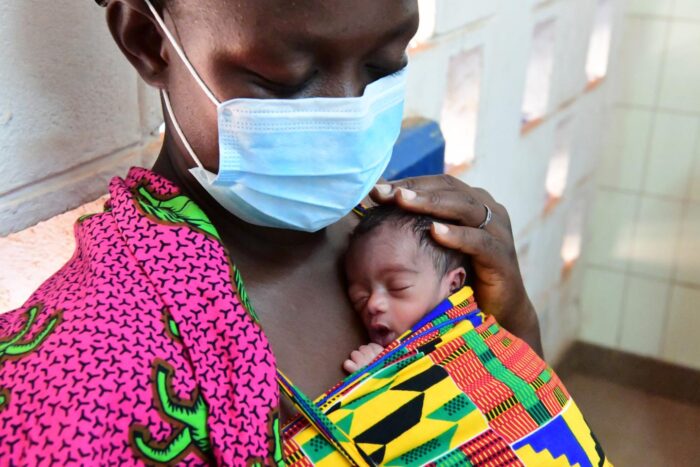Understanding Impact to Guide Recovery from COVID-19
In the year since the World Health Organization declared COVID-19 a pandemic and countries paused or scaled back health services, we have learned much about the impact of disruptions in essential health services on the lives of mothers and children worldwide and the urgent need to strengthen health systems.
With less than 10 years to meet Sustainable Development Goal-era targets for maternal and newborn health (MNH) and prevention of stillbirths, it is imperative that the MNH communities come together to share what has and has not worked during the pandemic to continue essential health services and strategize next steps to ensure mothers and babies not only survive, but thrive.
Trends in Impact
Late last year, UNICEF, in collaboration with country and regional offices, conducted a comparative analysis of use of essential health services in the second to fourth quarters of 2020, comparing it with the corresponding period in 2019. The analysis identified some clear macrotrends that will be important to consider as countries move forward in their pandemic recovery.
Most countries experienced some level of disruption in essential health services during the COVID-19 pandemic and the associated lockdowns, restriction of movement, interruptions in supplies, closing of health facilities, and redeployment and absenteeism of health workers. This was further compounded by reduction in demand due to anxiety, fear, and financial barriers in accessing health care. However, just as the degree of disruption varied among countries and regions, with countries in South Asia and Latin America suffering greater and more uniform disruptions than those in sub-Saharan Africa, where impact was patchy and moderate, it also varied by delivery platform. For example, both childhood immunization and facility-based care, including facility delivery, experienced initial sharp declines in the early months of the pandemic. But, while immunization was among the first service areas to recover (though still short of 2019 numbers), facility-based delivery is recovering far more slowly, and this area is likely to feel the pandemic’s impact into early 2021.
Another trend noted in the analysis was a uniform and continued reduction in the number of children diagnosed with or being treated for pneumonia and diarrhea. The cause of these decreases is not clear. They could be the result of better social distancing and handwashing, but they could also be due to underreporting in the community, declines in service use, or a combination of factors. In-depth analysis at the country level will be required to understand the determinants for massive and sustained reduction in service use for childhood illnesses across all regions.
The analysis clearly highlights that tracking coverage of essential health services alone is not enough; we must also monitor quality of care for those who seek services. Gaps in quality have further exacerbated reductions in coverage in many countries, as reflected in the number of stillbirths, stock-outs of essential commodities, and redistribution of human resources.
Accurate, reliable, real-time data from both public and private sectors will be critical to understanding the true impact of pandemic-related reductions in services and supporting full recovery. The pandemic has highlighted the fragility of many data systems and hesitancy to share data, underlining the need to ensure transparency in data sharing. There is also an urgent need for investment in data systems, especially in regions of Latin America and Central Asia. Immunization data systems, which have proven robust across all regions, can inform development of these systems and provide important lessons for the MNH community.
Strategies for Recovery
As more and better quantitative and qualitative data become available, it is essential that we use these data and the knowledge gained over the past year as we plan for recovery and build resilience against future shocks. Working with partners, countries must take this opportunity to put in place a government-led mechanism to monitor disruptions in service at both the national and subnational levels and track recovery in real time. Sustaining and supplementing budgetary allocations for maternal and newborn health backed up with necessary policy actions will be important to speed this recovery.
Understanding the factors behind reductions in use of services will guide strategies for recovery. For example, for outreach services such as immunization, supply-side bottlenecks may be a primary barrier, while for facility delivery, demand-side barriers such as fear and misinformation within the community may be a primary reason for avoidance. Major drivers in restoring trust and confidence—both among health workers and in the community—will be communication and infection prevention and control efforts. At the same time, efforts must be made to improve access and availability of services and supplies. As the pandemic runs deep and physical barriers such as nationwide lockdowns ease, the financial barriers in care seeking are now becoming more important.
Join us April 21, Day 2 of the Opening Forum of the AlignMNH Collective, for a panel discussion on the impact of COVID-19 on MNH, learnings from efforts to prioritize MNH during the pandemic, and how we can keep MNH high on the agenda once we’ve moved beyond immediate COVID response.
Gagan Gupta is a Maternal Newborn Health Specialist at UNICEF.
For more information, contact: Gagan Gupta (ggupta@unicef.org) or Luwei Pearson (lpearson@unicef.org)

